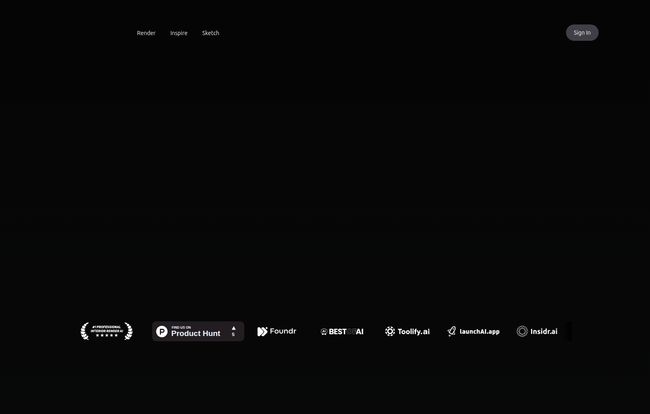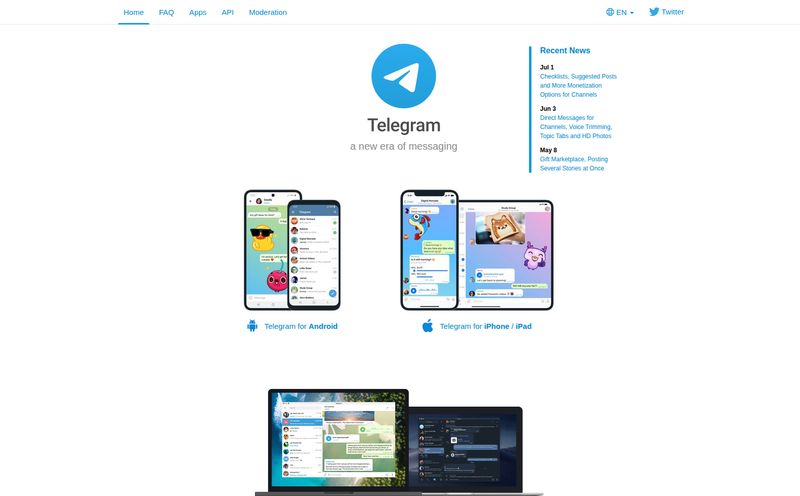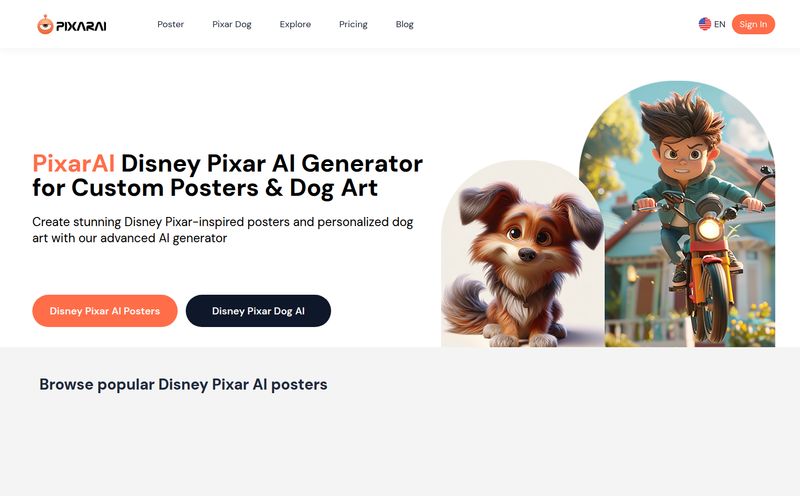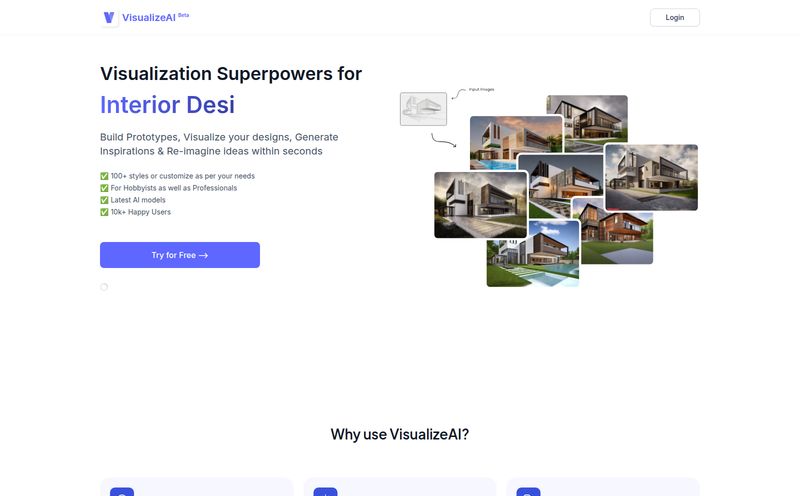We’ve all been there. You’re staring at your living room, the same beige walls you’ve had since you moved in, and you just know it could be something more. So you dive headfirst into the Pinterest rabbit hole, emerging hours later with 57 pins of clashing “Japandi” and “Maximalist” styles, and absolutely no clearer vision of what to do with your actual space. The gap between inspiration and reality is a canyon, and it's frustrating.
What if you could bridge that gap? Instantly? Like, snap a photo, type a few words, and see your drab living room transformed into a cozy Scandinavian retreat or a sleek, futuristic den. Sounds like science fiction, right? Well, not anymore. I’ve been playing around with a tool called Interior Render AI, and honestly, it feels a bit like holding a magic wand.
So What is Interior Render AI Exactly?
In the simplest terms, Interior Render AI is your on-demand interior designer, powered by artificial intelligence. You feed it a picture of a room—could be your own, could be a client’s, could even be a napkin sketch if you’re feeling bold—and then you tell it what you want. Think of it like a conversation. You say, “Show me this bedroom in a warm, minimalist style with oak furniture and lots of natural light,” and poof, it generates a high-quality rendering in seconds.
The creators are calling it the “GPT of the interior design,” and for once, the marketing hype isn't too far off. It uses that same kind of creative, generative thinking we've seen from text-based AI, but applies it visually to spaces. It’s less about just editing a photo and more about completely re-imagining it based on your prompts.

Visit Interior Render AI
How This Design Magic Actually Works
Getting started is ridiculously simple, which is something I deeply appreciate. There's no steep learning curve or clunky software to install. It’s all web-based and straightforward.
The process basically boils down to this:
1. Upload Your Image: You start by uploading a photo of the room you want to change. I tested it with a well-lit photo from my phone and a slightly blurry one I took at dusk. Pro tip: clearer, brighter photos definitely give the AI more to work with. You can also upload a hand-drawn sketch, which is a fantastic feature for designers who want to bring a rough concept to life quickly.
2. Describe Your Vision: This is where the fun begins. You can either choose from a list of preset styles like Scandinavian or Cyberpunk (yes, you read that right), or you can write your own custom prompt. This is where you can get specific. “Modern coastal living room with a large linen sofa, rattan chairs, and a view of the ocean through the window.” Go wild.
3. Generate and Iterate: Hit the button and wait a few seconds. The AI will spit out a brand new version of your room. Don't love the first one? Tweak your prompt or just run it again. You can generate multiple options to compare and find the perfect look.
The Good, The Bad, and The AI
No tool is perfect, right? After spending a good bit of time with Interior Render AI, I’ve got a pretty balanced view. The speed is its superpower. In the time it takes to make a cup of tea, you can have a handful of photorealistic design concepts. For a professional designer, this is an insane time-saver for mood boards and initial client pitches. For a homeowner, it’s a cure for decision paralysis.
The versatility is another huge win. The fact that it can handle everything from a simple style swap to turning a doodle into a fully-realized room is impressive. It’s not just a one-trick pony.
Now for the reality check. The quality of your output is heavily dependent on the quality of your input. A grainy, dark photo will likely yield a muddy, less-than-stellar result. Garbage in, garbage out, as they say. Also, while the AI is clever, it’s not a mind reader. Your text prompts need to be clear and descriptive to get what you really want. There’s a bit of an art to writing a good prompt, much like with other generative AI tools.
And the free trial credits, while great for a test drive, will run out. This isn't a completely free-for-all tool, which brings me to my next point…
Let's Talk Money and The Pricing Model
This is where Interior Render AI gets a big thumbs-up from me. In a world drowning in monthly subscriptions, they’ve gone with a pay-as-you-go credit system. Hallelujah! I have subscription fatigue, and I’m sure you do too. I don’t want to pay $20 a month for a tool I might only use for a single project every few months.
The pricing is transparent and pretty reasonable, making it accessible for both casual users and professionals. Here's a quick breakdown:
| Price | Credits |
|---|---|
| $1.99 | 10 Credits |
| $5.99 | 50 Credits |
| $8.99 | 100 Credits |
For my money, this model is a game-changer. It lowers the barrier to entry and you only pay for what you actually use. It respects the user's wallet, which is more than I can say for a lot of SaaS companies out there.
Who Is This Tool Actually For?
I can see a few groups getting a ton of value out of this. It’s not just for one type of person.
For the Pros: Designers and Architects
If you're a professional, time is money. Instead of spending hours in complex rendering software to create a few initial concepts, you can generate a dozen in minutes with Interior Render AI. It’s perfect for brainstorming, creating client-facing mood boards that look incredibly polished, and quickly visualizing ideas that pop into your head. It won't replace the final, detailed work in Revit or SketchUp, but it will dramatically speed up the initial creative and approval process.
For the Homebodies: DIYers and Real Estate Folks
If you're a homeowner, this is your secret weapon against costly design mistakes. Before you buy that expensive velvet couch or paint a wall a daring color, you can see how it will actually look in your space. For real estate agents, the application is obvious: virtual staging. Take a photo of an empty, soulless room and instantly furnish it in a variety of appealing styles to help buyers see the potential. It’s way cheaper and faster than physical staging.
Pushing Creative Boundaries Beyond Beige
One of the most delightful parts of this tool is the ability to break free from the ordinary. Sure, you can ask for “Modern Farmhouse,” and it will do a great job. But you can also ask for a “Gothic library with cyberpunk elements” or a “Surrealist dining room inspired by Salvador Dalí.”
This is where the tool transforms from a practical helper into a creative partner. It lets you explore wild ideas without any risk, pushing your own stylistic boundaries. I spent a solid half-hour just feeding it absurd prompts for my own office, and the results were fascinating. It’s a powerful engine for pure, unadulterated imagination.
Frequently Asked Questions
- Do I need any design skills to use Interior Render AI?
- Not at all! If you can take a picture and type a sentence, you can use this tool. It's designed to be intuitive for beginners, while still having enough depth for professionals.
- What kind of images or sketches work best?
- For photos, use clear, well-lit images taken from a straight-on or corner perspective. For sketches, a simple line drawing with clear definitions of walls, windows, and doors on a plain background works best.
- Is there a free trial?
- Yes, they typically offer a few free credits when you sign up so you can test the platform and see if it works for you before spending any money.
- How many credits does one design render cost?
- The cost per render can vary, but it's generally one or a few credits per generation. The platform makes it clear before you generate. With the base package, you can get several designs for just a couple of dollars.
- Can it change the layout of the room?
- Primarily, the tool re-imagines the style, colors, furniture, and finishes within the existing architectural shell of your photo. It doesn't knock down walls, but it can make a space feel entirely different.
- What if I don't like the generated design?
- Just try again! You can either re-run the same prompt for a different variation or tweak your description to be more specific. Part of the process is learning how to guide the AI to your desired outcome.
So, Is It Worth a Try?
Without a doubt, yes. Whether you’re a seasoned architect looking to speed up your workflow or just someone who’s sick of staring at boring walls, Interior Render AI is a powerful, accessible, and genuinely fun tool. It democratizes interior design, putting the power of high-end visualization into anyone's hands.
It’s not going to replace the nuanced skill of a human designer, but that’s not the point. It’s an assistant, a muse, a rapid-prototyping machine for your ideas. It’s the tool that finally lets you see what’s on the other side of that Pinterest board, right in your own home. And for the price of a coffee, you can start re-imagining your world. That sounds like a pretty good deal to me.



